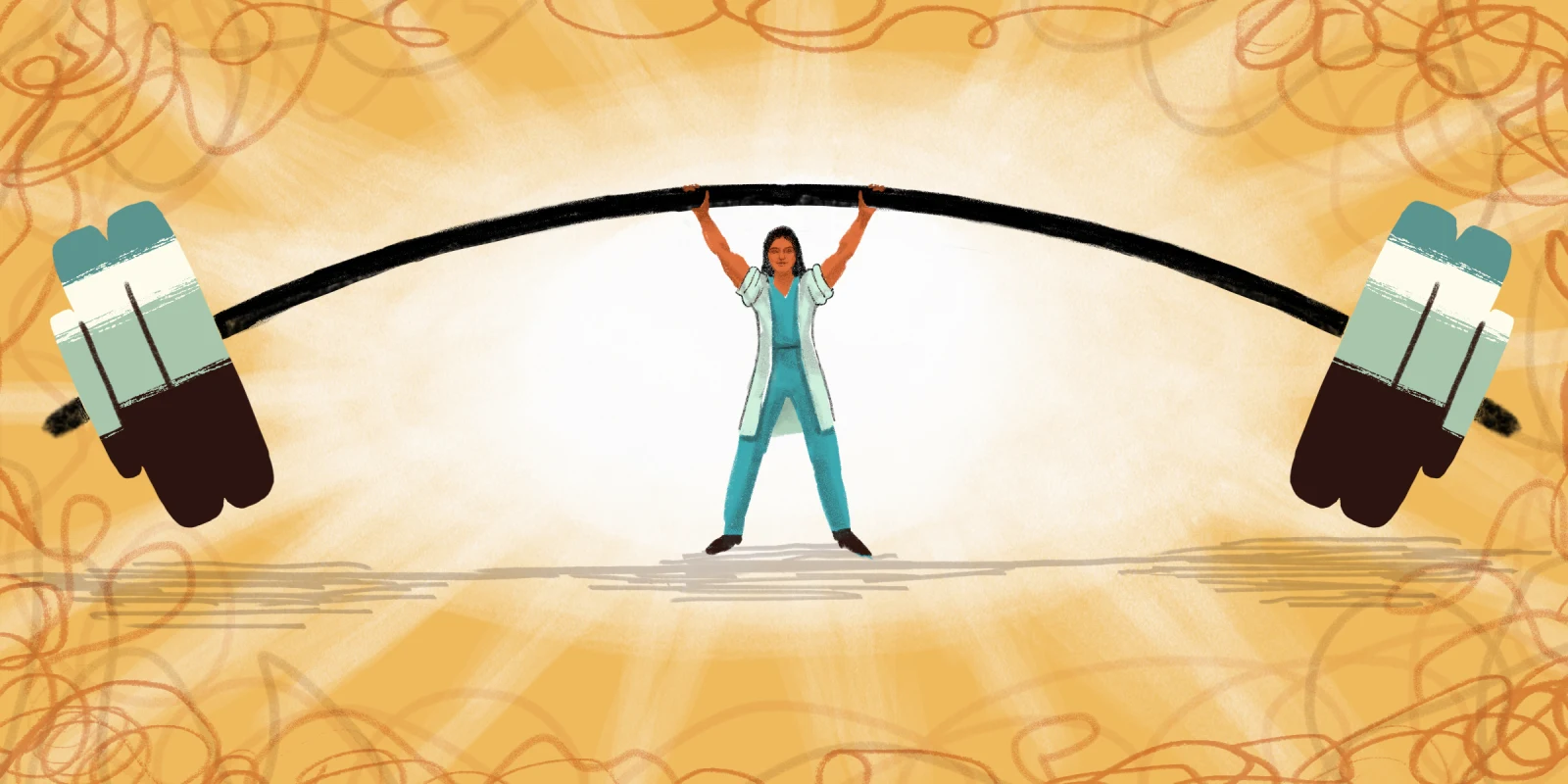“He basically told you that you have girl's knees,” one of my attendings retorted after I relayed the curbside diagnosis of patellofemoral syndrome I had received from one of the orthopaedic surgeons at our teaching hospital.
I was in my second year of residency and had just returned from a trip to Nice with my husband, during which I had noticed some knee pain as we walked up the winding staircases in search of panoramic city views.
The orthopaedic surgeon mentioned that there were exercises I could consider to help reduce my symptoms, but I never pursued them any further. After all, physical activity had hardly been a welcome presence in my life.
I grew up in the ‘80s and ‘90s when aerobics and diet culture reigned. Those forces shaped my negative body image as I unfavorably compared myself to the idealized pencil-thin female figure to which so many of us aspired back then. The goal was always to weigh less, which meant restricting my caloric intake and punishing myself with hours of cardio workouts. I struggled with my weight throughout adolescence, college, and medical school, pursuing the Sisyphean task of eliminating my curves at those moments when my body image was at its nadir.
Though my medical training espoused the virtues of leading a healthy lifestyle, it yielded little insight beyond vague platitudes about eating well and staying physically active. During residency, we were cautioned about the higher incidence of neck and back issues particular to ophthalmologists due to our frequent work with surgical loupes, microscopes, and slit-lamp machines, but we were offered no advice as to how to avoid it. Rather, we were encouraged to obtain disability insurance before beginning our practices.
My rigorous schedules as a medical student, resident, and fellow certainly did not make self-care easy. On busy surgical days, my supporting responsibilities assisting with cases and performing pre- and post-operative documentation meant I relied on vending machine lunches and dinners to power me through the day, only to crash later at night while hoping my pager would not go off.
Years later in my practice, I began to suffer from discomfort in my neck, shoulders, and back after long days filled with surgeries and procedures such as injectables and lasers. Colleagues would discuss ergonomic ways to structure our offices to minimize these issues, but it was to no avail. I also noticed my knee pain became particularly pronounced when I was seated for longer surgical cases and continued on my drive home after work. I was often holding on to the tension I felt in my neck and shoulders after a challenging surgical case or patient encounter, exacerbating the muscle stiffness that my day-to-day had started to induce.
Around this same time, my mom’s mobility became increasingly limited secondary to severe knee pain. She tried cortisone injections with little success, and reluctantly agreed to have knee replacement surgery. The surgery was complicated by a fall, a torn quad tendon, and subsequent extensive rehabilitation culminating in limited joint mobility – though the pain has subsided compared to her pre-surgery symptoms.
Witnessing the challenges my mom faced with her surgical recovery was sobering, particularly as she began developing these issues in her 60s, which seemed quite young to me. I was approaching 40 when she pursued her surgery and was already experiencing similar aches and pains. I could not fathom having such limited mobility in another 20 years, so I vowed to make a change.
Since my compliance with gym attendance had been abysmal in the past, I decided to try one located minutes from my office so that I could attend group classes after work. In signing up, I received a complimentary personal training assessment. I had never tried strength training before, so I signed up.
On the day of the evaluation, the trainer, Margaret, asked about my fitness goals, and I told her about my struggles with my weight and my concerns about reduced mobility as I aged. I was inspired by her personal story regarding how strength training had transformed her life, reducing her medication burden in managing a chronic health condition. We also discussed the stressful nature of my work and the frequent necessity to maintain fixed, awkward, and unsupported positions during procedures, examinations, and surgeries with patients.
Twice a week, I spent an hour with Margaret, learning the basics of functional fitness. We started with squats, lunges, and machine-assisted movements, always taking care to stop or readjust at the soonest sign of back pain or knee discomfort. She explained to me that much of my neck, shoulder, and back pain stemmed from inadequate strength in my core and posterior chain. She noted that my knee pain stemmed from a pelvic shift developed secondary to the positioning of my body at work during procedures and from insufficient strength in my glutes and quads, contributing to excess strain on the knee joints.
Before working with her, I associated strength training with Arnold Schwarzenegger and bodybuilders – not the lithe, feminine physical appearance I so coveted growing up. Margaret corrected my misconceptions, educating me on the importance of strength training, rather than cardio, for women, as declining estrogen levels lead to sarcopenia and loss of bone density. Research suggests that women can lose as much as 10% of their muscle mass during perimenopause alone, which means that banking muscle is critically important to counteract some of these natural, age-related changes.
Over the past two years, strength training has become a crucial part of my well-being – both physically and mentally. I have successfully stuck with our bi-weekly sessions, the longest run I’ve had with any type of physical activity in my entire life.
After a challenging day in the office, the hour I spend doing deadlifts, pushing the sled down the track, or barbell back squatting clears the tension I hold throughout the day and challenges my body. Any physical or emotional discomfort I am holding on to after a day of difficult cases or patient encounters is gone by the time I complete my training session. As my body becomes stronger and more toned, the neck, shoulder, back, and knee pain I had previously experienced after long surgical days is resolving.
For the first time in my life, I no longer view my visits to the gym as punishment for failing to reach a number on the scale. Instead, I view them as a gift to myself – a glorious hour spent strengthening my body and mind and investing in a healthful, mobile, and comfortable career and life. Just as Margaret’s story inspired me to make a change in my own life, I hope to encourage other female physicians to consider the importance of strength training both personally, as part of their self-care, and professionally, when counseling their female patients. Together, we can shift our focus toward getting stronger rather than slimmer.
What physical activities have improved your life as a clinician? Share below in the comments!
Dr. Mahsa Sohrab is an oculoplastic surgeon located in Greenwich, CT. When she is not busy managing her own practice, she enjoys writing, sewing, reading, and globetrotting with her husband and daughter. Follow her on Instagram @drmahsasohrab. Dr. Sohrab is a 2024–2025 Doximity Op-Med Fellow.
Illustration by Diana Connolly







